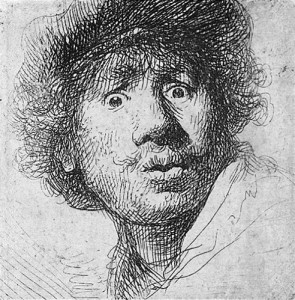Pinky says: Rembrandt across the centuries
In this day and age Rembrandt is one of the few artists that almost everyone knows and reveres. Four years ago huge celebrations of his 400th birthday took place around the globe, and so we are remiss in taking up his celebrity 4 years late, but then it is wise to fete him any time, any place, any year. Did you know that some called him vulgar, ignorant and greedy during his lifetime and often afterward? Rembrandt has often represented the bohemian, the liberal, the Romantic, and even the revolutionary. Opinions and beliefs about him have changed with the centuries. As late as the l950’s he was considered one of the great controversial figures. Critics were both attracted and repelled by his work. He was a superb colorist who couldn’t draw, a realist who ignored the classical canon.
Rembrandt attracted notice at an early age. He was famous during his lifetime. He always had admirers but he also had powerful detractors. One contemporary “authority” of Rembrandt wrote “The great painters paint nudes from which one can see that they know how to draw. Only an uneducated person tries to clothe his figures with clumsy dark garments…we cannot make head nor tail of them.” Rembrandt’s self portraits indicate his intentions; he painted reality. If people were ugly or deformed he painted them that way. There has always been a difference in the way that painters from the North and South of Europe saw life. Italian Renaissance artists painted the ideal life and saw it through rose colored glasses, while Northern painters tended to paint a road map of the face replete with the angst and suffering the subject had endured. This warts and all approach has largely been a point of criticism about Rembrandt.
However critics of the 17th and 18th centuries accepted him as a serious history painter and applauded his portraits, etchings and drawings. Rembrandt’s rise to the heights he occupies today came about with changes in taste. The authority of the Academy declined; interest in naturalism, and in human personality and psychological subtley grew. He became recognized as the painter of real life and of the human soul. New judgments arose about the ill visaged Jews, the beggars and bandy legged cripples, the gross slatterns. These pictures became acceptable because Rembrandt gave these humble subjects transcendent meaning.
By the middle of the 19th century he had become the icon of a Dutch Golden Age. He had lived for many years in the Jewish quarter of Amsterdam. His life conflated his biography and his art. Thus his personal bankruptcy led many people to feel empathy for him as an outsider. The critics made more of him as a social outcast, misunderstood in his own time. There also began the theory that here was a man of humble origin who rose through his art, and the myth of the bohemian artist emerged, together with the idea that Rembrandt was socially progressive and did not associate with royalty or the aristocracy, showing that it was possible for artists to challenge the social order, to live outside the confines of academic or conservative values, and still be successful–in the future if not in their own time. By the end of the 19th century Rembrandt had become a cult figure and achieved the status of the artist who was persecuted and denigrated in his own time but could now be recognized as a genius.
It was only in the period coming into the 20th century that connoisseurship came into its own. To see with one’s own eyes, to know and recognize the master’s hand, now became the basis of the discipline of art history. It was Rembrandt’s work that became the magnificent example of prior unappreciated genius. As a result of this reappraisal we are now presented with the constant discoveries of newly authenticated works by the master as well as decisions denying that works were his. A work in the Nelson Gallery has been visited by experts regularly in quest of its acceptance as a work painted by Rembrandt. His nudes now no longer are derided as lumpy sagging females; his biblical paintings now register depths of feeling that no other artist is able to portray. Gone are the critics who referred to his self portraits as grotesques, his scenes as vulgar misrepresentations of the truth of depiction. The Rembrandt Research Project, formed in the l960’s, separates Rembrandt from the Rembrandt mystique, the “extravagant mythologization” that resulted from his great fame on one hand and the lack of precise information about him on the other. The Rembrandt that has emerged is not the stubborn nonconformist or the master of a unique and mysterious technique but the head of a large workshop of students and assistants to whom he transmitted a “rational painting technique and pictorial and stylistic recipes.” However his hand could almost always be distinguished from those of his studio.
Today scholars work much more closely with conservators than in the past in order to know what pictures have condition problems, are overpainted, need cleaning, and there is a much greater interest in the technical means by which Rembrandt described naturalistic effects as opposed to simply judging his style. The National Gallery of Art Rembrandts have all been cleaned and the works now seem to have very different colors and a different sense of space. The chiaroscuro effects and the palette are very different. This has resulted in the viewer finding new ways of thinking about the way Rembrandt thought about his images. There are even new connections to other artists that critics are seeing in this new palette. Forty or fifty years from now it is believed that we will have a much more nuanced and subtle idea of Rembrandt’s paintings and drawings. We will know more about his house, his business, his family, his daily life. But to know his character we will have to do what people have always done: we will have to look at his paintings. That is exactly what we did in Amsterdam; we spent a lengthy time communing with one of Rembrandt’s Old Men in the Rijksmuseum and we found everything we needed to know about Rembrandt’s talent, his portrayal of old age, his understanding of the human condition. He had reached out to us across the centuries. For us it seemed that we had made real contact, and this was thrilling. Happy 404th birthday Rembrandt!



Leave a Reply